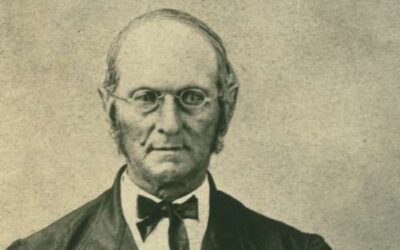The Great Disappointment and Lessons It Teaches Us
On October 22, 1844, thousands of Christians in the Northeastern United States eagerly watched the skies for what they believed would be the second coming of Jesus Christ.
These believers were known as “Millerites” because they were currently following the Scriptural interpretations of a farmer and veteran soldier turned Baptist minister, William Miller. These interpretations focused on the 2,300-day prophecy in Daniel 8:14.
Miller believed the Second Coming to be literal and imminent. And one of his most zealous followers was convinced that the very date of Jesus’ return would be in October of 1844. Then Jesus’ followers would be taken to heaven, and the earth would be cleansed of sin by fire.
But when Jesus did not appear as expected, the Millerites became understandably discouraged. Many of them gave up on their faith in Christianity altogether.
This day was such a blow to the Millerite movement that it became known as The Great Disappointment.
But on the other hand, this day is also an important marker in pre-Seventh-day Adventist history. Pioneers of what would soon become the Advent Movement, such as James and Ellen White and Hiram Edson, responded to the Great Disappointment by going back to Scripture to better understand why or how October 22, 1844 might have been significant.
And these same diligent students of Scripture—through prayerful, Spirit-led study—would eventually lay the foundation for the Seventh-day Adventist Church (organized in 1863).
So let’s unpack the prophecy surrounding the year of 1844, as well as what it means to Seventh-day Adventists and other Christians. You’ll learn about:
- What people thought would happen in 1844
- What happened on October 22, 1844
- What happened after the Great Disappointment
- Why 1844 is significance and what we can learn from it
What did people think was going to happen in 1844?
Millerite Christians believed Jesus was going to return to Earth as the Bible describes in 1 Thessalonians 4:16-18. They expected Him to appear in the sky, resurrect believers who had died, take His followers to heaven, and cleanse the earth by fire in judgment upon evil and sin. They chose this date based on a prophecy in Daniel 8:14, which spoke about God “cleansing” (KJV translation) of the “sanctuary,” which they believed to be the earth.
To understand why, let’s look at the events that led up to the Millerite movement.
Years before 1844, William Miller began fervently studying the Bible, with a special interest in prophecy and what was in store for eternity.1 He took into consideration all parts of the Bible, tying together visions from Ezekiel, verses from Numbers, visions from the book of Daniel, and the apocalyptic book of Revelation to discover what he called the 2,300-day prophecy.2
This prophecy is complex enough for an entire article. But in summary, Daniel 8:14 was its cornerstone:
“And he said to me ‘For two thousand three hundred days; then the sanctuary shall be cleansed” (NKJV).

Photo by Sincerely Media on Unsplash
Miller believed that cleansing the sanctuary meant cleansing the earth, or purifying it, by fire. He referenced passages from all over the Bible to determine this, such as Isaiah 60:13,1 Kings 8:27, and Revelation 5:10.3
Then, his study of verses like Ezekiel 4:6 and Numbers 14:34 led him to realize that in apocalyptic and prophetic biblical literature, a mention of a day actually symbolized a year.4
This meant that the 2300 days of Daniel 8:14 would have meant 2300 years, a span that started in 457 BC, with Artaxerxes’ decree to rebuild Jerusalem (Daniel 9:25).5
With this knowledge, Miller felt that Jesus was going to return sometime between March 21, 1843, and March 21, 1844. But he didn’t set a specific date.
However, when Jesus didn’t return by March 21, 1844, one of his followers suggested that maybe they shouldn’t have made their calculations using the rabbinical Jewish calendar. They set the date April 18-19, 1844, which was based on the Karaite Jewish calendar.
Discouragement began to set in when this date also failed, but a later date—October 22, 1844—was adopted after a follower of Miller, Samuel Snow, gave a lecture at an August camp meeting about the starting date of the prophecy. This date was based on the belief that Jesus’ Second Coming would fulfill the Jewish feast called the Day of Atonement that foreshadowed God’s judgment. It fell on the tenth day of the seventh month (Leviticus 23:27). In 1844, that day was October 22.6
Miller’s followers, the Millerites, enthusiastically clung to the idea that the Second Advent could be predicted and prepared themselves for Jesus’ soon return. So, when October 22, 1844 came and went, many were so disappointed that they left the movement.
Not all of them lost their faith, however. (More on this later.)
What happened on October 22, 1844?

Photo by Artiom Vallat on Unsplash
This was the day Millerites all across North America waited expectantly for Jesus to return. But as the final hours of the day ticked away, nothing happened. Turns out, though, that something did happen on this date, but it wasn’t what Miller and his followers thought would happen.
Jesus Didn’t Return
Many who experienced the Great Disappointment didn’t believe anything happened that day. They simply chalked it up to a false religious excitement and gave up on the teachings of the Millerite movement.
In the months after the Disappointment, though, some became certain something had happened. But what could it have been?
Jesus Began Cleansing the Sanctuary
Some Millerite believers, including a New York farmer, Hiram Edson. He prayed that God would guide His believers to better understand the message of the Scriptures.
God heard their desire to know the truth, and what happened next was miraculous. The Review and Herald, an Adventist publication, tells us Hiram Edson’s story:
“After breakfast I said to one of my brethren, ‘Let us go to see and encourage some of our brethren.’ We started, and while passing through a large field, I was stopped about midway in the field. Heaven seemed open to my view, and I saw distinctly and clearly that instead of our High Priest coming out of the most holy place of the heavenly sanctuary to this earth on the tenth day of the seventh month, at the end of the 2300 days, He, for the first time, entered on that day into the second apartment of that sanctuary, and that he had a work to perform in the most holy place before coming to the earth; that He came to the marriage, or in other words, to the Ancient of days, to receive a kingdom, dominion, and glory; and that we must wait for His return from the wedding.”7
Edson, along with two friends and fellow believers Hahn and Crosier, studied the Scriptures together and discovered that Miller had misinterpreted Daniel 8:14. The “sanctuary” of that verse wasn’t the earth or the earthly church.
Rather, the cleansing of the sanctuary of Daniel 8 was a heavenly event (Daniel 7:9-10; 1 Peter 4:17; Revelation 20:12; Matthew 22:1-14).8
Put simply, Seventh-day Adventists believe that in 1844, Jesus began the final phase of His ministry in Heaven: cleansing the heavenly sanctuary, a process of judgment that must occur before Jesus can return again. This means that Jesus moved from the Holy Place to the Most Holy Place and began the process of reviewing the names and examining the hearts of those who profess to be believers (Hebrews 8:1-5; Daniel 7:9-27).

Photo by Chris Brignola on Unsplash
In other words, the heavenly sanctuary contains a record of our lives, including every sin and every decision for Christ (Ecclesiastes 12:14). The judgment—or “cleansing”—that is happening in heaven right now is the cleansing of the record of sins for those who choose God and accept the salvation of Jesus.
This new light about the cleansing of the heavenly sanctuary, paired with the concept of the Day of Atonement, eventually became a distinct doctrine (the Investigative Judgment, or Pre-Advent Judgment) in the Seventh-day Adventist denomination, which grew out of the Advent movement.9
While the word “judgment” can have a negative or fear-inducing connotation to us, there is actually much we can take from this doctrine to give us blessed hope.
This doctrine holds that on October 22, 1844, Christ entered the holiest part of the heavenly sanctuary and has been interceding for us ever since. Jesus is going through our names in the Book of Life, and giving salvation freely to all who choose Him.
Through prayerful study of the Bible, what was once a “Great Disappointment” ended up leading many believers to new hope in Jesus and His plan of salvation.
It also led them to realize, based on scripture, that they shouldn’t be trying to pinpoint the exact date of Jesus’ return. Indeed, the Bible says that “no one knows the day or the hour” of the Second Advent (Matthew 24:36, NKJV).
Yet, God can use us for good even in our errors. Out of the misinterpretation of the Millerites came a group of believers who valued sincere and prayerful Bible study and trust in God over human calculations.
Now, let’s explore how the event impacted believers at the time and what came out of the Great Disappointment, both good and bad (but mostly good!).
What happened after the Great Disappointment?
The Great Disappointment divided early believers in the Advent and Millerite movements, leaving some people disheartened and disillusioned and others with a hunger to study their Bibles and figure out where they’d gone wrong.

Photo by Julia Florczak on Unsplash
A lot of former believers abandoned the movement. The anger and sadness they felt when Jesus didn’t return in 1844 was simply too much. Many went back to their previous congregations and traditions.
And for many others, the repercussions from the Great Disappointment were serious. People had sold all of their possessions, including their homes. They also experienced ridicule, and even violence, from those around them when Jesus did not return. Several churches were vandalized, and unbelievers taunted them with questions like “Have you not gone up?”
For others, the Great Disappointment pushed them to dive back into the Scriptures and discover what they had misunderstood. They banded together to help each other. One believer in particular who felt a need to dig deeper into the Bible after the Great Disappointment was Ellen White (then Ellen Harmon).
Ellen White and her family were among the Millerites who believed Jesus would be coming on October 22nd.
She recalls that day:
“It was hard to take up the vexing cares of life that we thought had been laid down forever. It was a bitter disappointment that fell upon the little flock whose faith had been so strong and whose hope had been so high…We were disappointed but not disheartened.”
Though this moment in time was disappointing for many, Ellen White’s sincere conviction and belief in the Bible helped guide others out of the confusion of The Great Disappointment and into the hope that lay ahead for the Advent Movement.
Soon after the Disappointment, through further Bible study and guidance from the Holy Spirit, Ellen White gained a clearer understanding of the Second Coming and what was happening in the heavenly sanctuary. She corrected believers who still thought Jesus’ return was happening in a matter of weeks or months and led them to see that the future was still open to do work for the Lord.
These insights also led former Millerites to move away from a popular theology among Millerites at the time: the shut-door theology.
This theology stated that after October 22, 1844, those who hadn’t accepted William Miller’s message could not be saved. The door of salvation was “shut.”
God began to shed light to His followers that salvation was still available for every person He ever created. This renewed hope for many and helped to reshape early Adventist ideas about salvation.
Ellen White’s experience of the Great Disappointment may have been briefly saddening, but the long term impact led her to further study the Bible and remain open to God’s guiding light.
Because she and other believers were influenced by this event to study the Bible even more, they also discovered other concepts that hadn’t been given much thought before. Important principles like the seventh-day Sabbath, the investigative judgment, how we should take care of ourselves, and more. All that came out of sincere, spirit-led Bible study.
The Great Disappointment certainly had an immediate impact on those who were actually there, but what kind of impact does it continue to have today?
What can we learn from the Great Disappointment today?
The Great Disappointment has a lot of implications for Seventh-day Adventists today as well as all believers in Jesus.
Dependence on God and the Bible for guidance

Photo by Patrick Fore on Unsplash
Those that lived through the Great Disappointment learned firsthand how important it is to back up theological claims with the Bible and prayerful study.
The leaders of the Seventh-day Adventist Church displayed this kind of dependence on the Bible and on God. Through their study and prayer, they helped establish the Seventh-day Adventist Church and guide believers to new perspectives on salvation and the heavenly sanctuary.
It also teaches us that…
God’s timing is not like our timing

Photo by Aron Visuals on Unsplash
The Bible highlights the importance of waiting on the Lord:
“Wait on the Lord; Be of good courage; and He shall strengthen your heart; Wait, I say, on the Lord” (Psalm 27:14, NKJV).
October 22, 1844 really puts verses like this one into perspective. Human beings have a limited perspective of time. We are finite beings, while God is infinite. And God’s timing is perfect, and when we put our faith in His timing, He will guide us and strengthen us.
Be perpetually ready for Jesus’ second coming
Admittedly, it’s easy to become an alarmist as soon as it seems the world is in crisis. When something bad happens, it’s natural to want it to mean something more than just another manifestation of sin. Sometimes people still try to set a time period for Jesus’ return, only to be disappointed when years pass and He does not.
Rather than being swayed by human opinion and anxiety, we can maintain a daily relationship with Jesus. This helps us always stay ready for His return, allowing us to live our lives in peace and trust in God’s plan for us.
We can follow Paul’s guidance for us:
“Rejoice in hope, be patient in tribulation, be constant in prayer” (Romans 12:12, NKJV).

Photo by Gift Habeshaw on Unsplash
The Bible calls us to remain steady in our faith that Jesus will come again.
In the end, no matter what is happening in the world or our immediate society at the time, we can have hope in the second advent of Jesus.
The Great Disappointment will be an even more distant memory as one day, we will no longer feel disappointment by the expectations of this life.
Until then, let’s prayerfully read the Bible and learn about the wonder of God’s love and His plan of salvation for us.
If you’re interested in learning more about the plan of salvation, prophecy, or the history of the Seventh-day Adventist Church, check out our Bible study page.
- Loughborough, J.N., The Great Second Advent Movement, p. 102. [↵]
- Ibid., p. 94. [↵]
- Miller, William, On the Cleansing of the Sanctuary. [↵]
- Pfandl, Gerhard, “In Defense of the Year-Day Principle,” Journal of the Adventist Theological Society. [↵]
- Maxwell, Mervyn, Tell It to the World, p. 26. [↵]
- Ibid., p. 28–31. [↵]
- “The Spirit of 1844,” Review and Herald, June 23, 1921. [↵]
- Damsteegt, P. Gerard, “The Sanctuary and Adventist Experience.” [↵]
- “What Adventists Believe About Christ’s Ministry in the Heavenly Sanctuary,” Seventh-day Adventist Church. [↵]
More Answers
Protestant Reformation
Martin Luther. The 95 Theses. The Reformation. The Protest. Maybe you’ve heard these terms and wondered, What’s the big deal?
Who was J.N. Andrews and How Did He Contribute to Adventism?
John Nevins Andrews (1829–1883) was an influential leader in the early days of the Seventh-day Adventist Church. He was a Bible scholar who helped shape several Adventist beliefs and juggled many roles in the Church. Most notably, he was the first official missionary for the Adventist Church outside North America.
What Does “Adventist” Mean
Seventh-day Adventists are a Protestant Christian denomination who hold to the biblical seventh-day Sabbath. From this belief, they get the first part of their name.
William Miller
William Miller was a farmer in the early 1800s who gave his life to God and began intensely studying his Bible. This study led him to some unexpected conclusions, namely that Jesus Christ would come back to earth in his lifetime—in 1843 or 1844. As Miller began sharing this news, he sparked a religious revival in North America called the Millerite Movement.
Who Was James Springer White?
James Springer White (1821–1881) was a key figure in the Seventh-day Adventist Church and the husband of Ellen G. White. He played an active part in the Millerite Movement, waiting for Jesus to return in 1844. When this didn’t happen, he joined with other Millerites, including his wife, to continue studying Scripture and eventually begin the Adventist Church.
Seventh-day Adventist Founders
The key figures and founders of Seventh-day Adventism were a group of people from various Protestant Christian denominations who were committed to studying the Word of God and sharing about Jesus Christ.
Joseph Bates
Joseph Bates was a sailor-turned-preacher who joined the Millerite Movement and waited for the Second Advent of Jesus to happen in 1844. Despite being disappointed when this didn’t occur, Bates held onto his faith and played an integral part in starting the Seventh-day Adventist Church.
The Millerite Movement
The Millerite Movement was a religious revival that followed the Second Great Awakening in North America. It started with William Miller, an earnest student of the Bible. Due to a misinterpretation of a prophecy in the book of Daniel, he and his followers concluded that Jesus Christ was coming back sometime around 1843 or 1844.
Didn’t find your answer? Ask us!
We understand your concern of having questions but not knowing who to ask—we’ve felt it ourselves. When you’re ready to learn more about Adventists, send us a question! We know a thing or two about Adventists.









